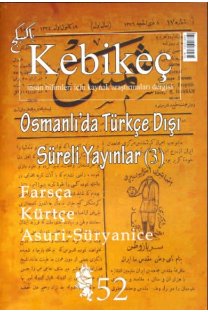Asur-İmparatorluğu'nda Gündelik Hayat Üzerine: Urad-Gula'nın Mektubu K.4267
Asur İmparatorluğu'nda gündelik hayat ile ilgili yeni bir okumayla bir Yeni-Asur mektubunu inceleyen bu çalışma, konu ile ilgili araştırmalar için bir örnek sunmayı hedeflemiştir. K.4267 envanter numaralı Yeni-Asur mektubu tanıtılmakta, transkripsiyonu ve çevirisi verildikten sonra, mektubun yazarının Asur İmparatorluğu dönemi gündelik hayatla ilgili öne çıkardığı öğeler tartışılmaktadır.
On Daily Life in the Assyrian Empire: Urad-Gula's Letter K.4267
This study provides a reading of daily life in the Assyrian Empire based on a Neo-Assyrian letter and seeks to establish a precedent for future research on the topic. The introduction to, the transliteration and translation of Neo-Assyrian letter K.4267 is followed by the discussion of various elements of daily life in the Assyrian Empire as emphasized by the author of the letter
___
- Fahd, Toufic. La divination arabe: Études religieuses, sociologiques et folkloriques sur le milieu natif de l'Islam. Leiden: Brill. 1966.
- Galil, Gershon. The Lower Stratum Families in the Neo-Assyrian Period. Leiden ve Boston: Brill. 2007.
- Gökçek, L. Gürkan. Asurlular. Ankara: Bilgin Kültür Sanat Yayınları. 2015.
- Gurney, Oliver R. ve Jacob J. Finkelstein. The Sultantepe Tablets I. Londra: The British Institute of Archaeology at Ankara. 1957.
- Gurney, Oliver R. ve Peter Hulin. The Sultantepe Tablets II. Londra: The British Institute of Archaeology at Ankara, 1964.
- Hämeen-Anttila, Jaakko. "Arabian Prophecy" Martti Nissinen, ed. Prophecy in its Ancient Near Eastern Context: Mesopotamian, Biblical, and Arabian Perspectives. Atlanta: Society of Biblical Literature (2000): 115-146.
- Hirst, Jacqueline ve Geeta Pandey. Growing up in Hinduism. Londra: Longman, 1990.
- Hurowitz, Victor Avigdor. "ABL 1285 and the Hebrew Bible. Literary Topoi in Urad-Gula's Letter of Petition to Assurbanipal" State Archives of Assyria Bulletin 7 (1993): 9-17.
- Ito, Sanae. "A Letter from Assurbanipal to Enlil-b?ni and the Citizens of Nippur" Fragmentations 4 (2013): 19-34.
- Jiménez, Enrique, ve Selim F. Adalı, "The 'Prostration Hemerology' Revisited: An Everyman's Manual at the King's Court" Zeitschrift für Assyriologie 105 (Yayınlanacak).
- Kanitkar, V. P. Hemant ve W. Owen Cole. Teach Yourself Hinduism. Londra ve Chicago: Hodder ve NTC/Contemporary Publishing. 1995.
- Köroğlu, Kemalettin. Eski Mezopotamya Tarihi. Başlangıcından Perslere Kadar. İstanbul: İletişim Ya- yınları. 2006.
- Livingstone, Alasdair. "Ashurbanipal: Literate or Not?" Zeitschrift für Assyriologie 97 (2007): 98-118.
- Livingstone, Alasdair. Hemerologies of Assyrian and Babylonian Scholars. Bethesda, Maryland: CDL Press. 2013.
- Luukko, Mikko. "On Standardisation and Variation in the Introductory Formulae of Neo- Assyrian Letters" Iraq 74 (2012): 97-115.
- Nissinen, Martti. References to Prophecy in Neo-Assyrian Sources. Helsinki: Helsinki University Press. 1998.
- Oppenheim, A. Leo ve Erica Reiner. Ancient Mesopotamia. Portrait of a Dead Civilization. Chicago ve Londra: The University of Chicago Press. 1977.
- Parpola, Simo. "Assyrian Royal Inscriptions and Assyrian Letters" F. Mario Fales, ed. Assyrian Royal Inscriptions: New Horizons in Literary, Ideological, and Historical Analysis. Papers of a Symposium Held in Cetona (Siena), June 26-28, 1980. Roma: Istituto per l'Oriente (1981): 117-142.
- Parpola, Simo. "The Forlorn Scholar" F. Rochberg-Halton, ed. Language, Literature, and History. Philological and Historical Studies Presented to Erica Reiner. New Haven: American Oriental Society (1987): 257-278.
- Parpola, Simo. Letters from Assyrian and Babylonian Scholars. Helsinki: Helsinki University Press. 1993.
- Parpola, Simo. Assyrian Prophecies, Helsinki: Helsinki University Press. 1997.
- Parpola, Simo. "Cuneiform Texts from Ziyaret Tepe (Tu??an), 2002-2003" State Archives of Assyria Bulletin 17 (2008): 1-113.
- Pedersen, Olof. "Private Archives in Assur compared with other sites" State Archives of Assyria Bulletin 1 (1987): 43-52.
- Ponchia, Simonetta. "Administrators and Administrated in Neo-Assyrian Times" G. Wilhelm, ed. Organization, representation, and symbols of power in the ancient Near East : proceedings of the 54th Rencontre assyriologique internationale at Wuerzburg, 20-25 July 2008. Winona Lake, Indiana: Eisenbrauns (2012): 213-224.
- Postgate, J. Nicholas ve Julian E. Reade. "Kal?u" Reallexikon der Assyriologie 5 (1976-1980): 303
- Radner, Karen "Provinz. C. Assyrien" Reallexikon der Assyriologie 11 (2006): 42-68.
- Potts, Daniel T. "Before Alexandria: Libraries in the Ancient Near East" Roy MacLeod, ed. The Library of Alexandria. Centre of Learning in the Ancient World. Londra ve New York: I. B. Tauris (2010): 19-33.
- Radner, K. "An Imperial Communication Network: The State Correspondence of the Neo- Assyrian Empire", K. Radner, ed. State Correspondence in the Ancient World. From New Kingdom Egypt to the Roman Empire. Oxford: Oxford University Press (2014): 64-93.
- Schloen, J. David. The House of the Father as Fact and Symbol. Patrimonialism in Ugarit and the Ancient Near East. Winona Lake, Indiana: Eisenbrauns. 2001.
- Sevin, Veli. Yeni Assur Sanatı I. Mimarlık. Ankara: Türk Tarih Kurumu Basımevi. 1999.
- Sevin, Veli. Yeni Assur Sanatı II. Assur Resim Sanatı. Ankara: Türk Tarih Kurumu Basımevi. 2010.
- Stol, Marten ve Frans A. M. Wiggermann. Birth in Babylonia and the Bible. Its Mediterrenean Setting. Groningen: Styx Publications. 2000.
- Stowers, Stanley K. "Theorizing the Religion of Ancient Households and Families" John Bodel ve Saul M. Olyan, ed. Household and Family Religion in Antiquity. Malden, MA ve Oxford: Blackwell (2008): 5-17.
- Tadmor, H. "Propaganda, Literature, Historiography: Cracking the Code of the Assyrian Royal Inscriptions" Simo Parpola ve Robert M. Whiting, ed. Assyria 1995. Proceedings of the 10th Anniversary Symposium of the Neo-Assyrian Text Corpus Project, Helsinki, September 7-11, 1995. Hel- sinki: The Neo-Assyrian Text Corpus Project (1997): 325-338.
- ISSN: 1300-2864
- Yayın Aralığı: Yılda 2 Sayı
- Başlangıç: 1995
- Yayıncı: Mehtap Yüksel
Sayıdaki Diğer Makaleler
Hüsamettin Bozok'tan Ömer Faruk Toprak'a Bir Mektup ve Pınar Dergisi
Asur-İmparatorluğu'nda Gündelik Hayat Üzerine: Urad-Gula'nın Mektubu K.4267
Son Hükümler: 1980'lerde Hapishanelerden Yazılan Son Mektupların Anlatı Çözümlemesi Denemesi
A Local "Left-wing" Journal: Başak Adana-1946
Türkiye'de Modern Psikolojinin Tarihi: 'İlm-i Ahvâl-i Ruh 'İlmü'n-Nefs/Ruhiyyat
Lozan Mübadelesi'nin Ekonomik Sonuçlarını Emval-i Metruke Kanunları Üzerinden Okumak
